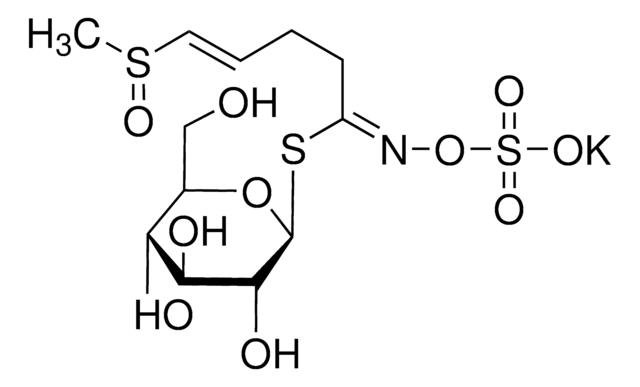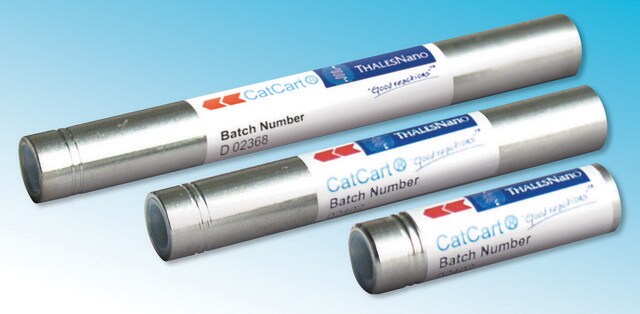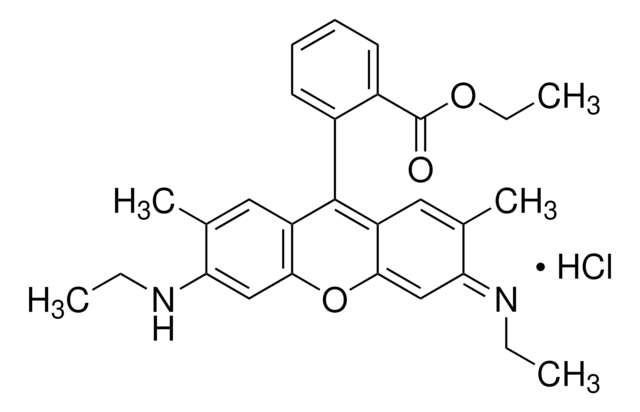Alle Fotos(4)
Wichtige Dokumente
SBR00072
Rhodamine Labeled D-galactosamine
Suitable for fluorescent microbial imaging
Anmeldenzur Ansicht organisationsspezifischer und vertraglich vereinbarter Preise
Alle Fotos(4)
About This Item
Empirische Formel (Hill-System):
C31H33N3O9
Molekulargewicht:
591.61
UNSPSC-Code:
12352201
NACRES:
NA.26
Empfohlene Produkte
Qualitätsniveau
Form
solid
Lagertemp.
−20°C
SMILES String
CC(C=C)=[N+](C)C.OC[C@H]1OC(O)[C@H](NC(C(C=C2)=CC(C([O-])=O)=C2C3=C4C=CC(C=C4OC5=C3C=CC(N(C)C)=C5)=[N+](C)C)=O)[C@@H](O)[C@H]1O.[O-]C=O
Allgemeine Beschreibung
Bacterial Peptidoglycan is a polymer consisting of glycans and short peptides, a multilayer rigid structure that forms the cell wall. D-sugars and D-amino acids (DAA) are metabolically incorporated into the bacterial cell. It was recently discovered that transpeptidases enzymes catalyze the metabolic incorporation of exogenous D-sugars and DAAs with almost no restriction of the side-chain identity. Modification of a D-sugar, such as D-Galactosamine, with molecular fluorophores provides fluorescent probes that can efficiently label in situ peptidoglycan in diverse bacterial species.
Rhodamine-labelled D-Galactosamineis a fluorescent derivative of D-Galactosaminethat is obtained by a synthetic conjugation of D-Galactosamineto the fluorophore. Rhodamine-labelled D-Galactosamine has high biocompatibility and suitability for labeling peptidoglycans in live bacteria. Additionally, it can be used in tandem with other stains such as FITC-labelled Alanine (#SBR00049) to distinguish between different bacteria. Other compatible products useful for live staining include: Rhodamine B labelled Polymyxin B, and Ramoplanin, FITC Labelled D-Lysine, Alanine or Vancomycin and Dansyl labelled polymyxin B (catalog numbers: SBR00036, SBR00047, SBR00050, SBR00049, SBR00028, SBR00029).
Rhodamine-labelled D-Galactosamineis a fluorescent derivative of D-Galactosaminethat is obtained by a synthetic conjugation of D-Galactosamineto the fluorophore. Rhodamine-labelled D-Galactosamine has high biocompatibility and suitability for labeling peptidoglycans in live bacteria. Additionally, it can be used in tandem with other stains such as FITC-labelled Alanine (#SBR00049) to distinguish between different bacteria. Other compatible products useful for live staining include: Rhodamine B labelled Polymyxin B, and Ramoplanin, FITC Labelled D-Lysine, Alanine or Vancomycin and Dansyl labelled polymyxin B (catalog numbers: SBR00036, SBR00047, SBR00050, SBR00049, SBR00028, SBR00029).
Anwendung
Fluorescent labeled sugars can be used for many applications including:
- Bacterial cell wall morphology
- Bacterial cell wall formation or remodeling activity
- Bacterial viability/activity
- Identify bacterial activity on surfaces or in substances
- Differentiation between various bacterial strains according to their incorporation profile of different D amino acids and sugars
Hinweis zur Analyse
- Fluorescent microscopy application: Rhodamine-labelled D-Galactosamine has excitation/emission wavelength range at 542-582/604-644 nm.
- The recommended working concentration in fluorescent microscopy imaging application is between 250-500 µM in working medium.
- Aliquots of the DMSO solution can be stored at -20⁰C, protected from light for at least one month.
Ähnliches Produkt
Produkt-Nr.
Beschreibung
Preisangaben
Lagerklassenschlüssel
11 - Combustible Solids
WGK
WGK 3
Flammpunkt (°F)
Not applicable
Flammpunkt (°C)
Not applicable
Hier finden Sie alle aktuellen Versionen:
Analysenzertifikate (COA)
Lot/Batch Number
It looks like we've run into a problem, but you can still download Certificates of Analysis from our Dokumente section.
Wenn Sie Hilfe benötigen, wenden Sie sich bitte an Kundensupport
Besitzen Sie dieses Produkt bereits?
In der Dokumentenbibliothek finden Sie die Dokumentation zu den Produkten, die Sie kürzlich erworben haben.
Phuong Luong et al.
ACS infectious diseases, 8(4), 889-900 (2022-03-19)
Bacterial cell envelope glycans are compelling antibiotic targets as they are critical for strain fitness and pathogenesis yet are virtually absent from human cells. However, systematic study and perturbation of bacterial glycans remains challenging due to their utilization of rare
Sheng Hong et al.
Chemical science, 11(17), 4403-4409 (2020-11-20)
Accumulating evidence indicates that colonized microbes play a crucial role in regulating health and disease in the human body. Detecting microbes should be essential for understanding the relationship between microbes and diseases, as well as increasing our ability to detect
Yen-Pang Hsu et al.
Chemical science, 8(9), 6313-6321 (2017-10-11)
Fluorescent d-amino acids (FDAAs) enable efficient in situ labeling of peptidoglycan in diverse bacterial species. Conducted by enzymes involved in peptidoglycan biosynthesis, FDAA labeling allows specific probing of cell wall formation/remodeling activity, bacterial growth and cell morphology. Their broad application
Helene Botella et al.
mBio, 8(5) (2017-09-14)
Peptidoglycan (PG), a polymer cross-linked by d-amino acid-containing peptides, is an essential component of the bacterial cell wall. We found that a fluorescent d-alanine analog (FDAA) incorporates chiefly at one of the two poles in Mycobacterium smegmatis but that polar
Unser Team von Wissenschaftlern verfügt über Erfahrung in allen Forschungsbereichen einschließlich Life Science, Materialwissenschaften, chemischer Synthese, Chromatographie, Analytik und vielen mehr..
Setzen Sie sich mit dem technischen Dienst in Verbindung.







